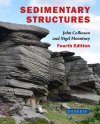Textbook
By: John Collinson(Author), Nigel Mountney(Author)
340 pages, 300+ colour photos, colour & b/w illustrations; tables
![Sedimentary Structures Sedimentary Structures]()
Click to have a closer look
About this book
Contents
Customer reviews
Biography
Related titles
About this book
Now enhanced with colour photographs and illustrations, this thoroughly revised fourth edition of Sedimentary Structures enhances its status as a major textbook in geology. Since its first publication in 1982, Sedimentary Structures has established and maintained itself as a pre-eminent resource that sets out a clear methodology and philosophy for understanding present-day sediments and sedimentary rocks as the product of dynamic processes.The fourth edition of this classic textbook introduces erosional, depositional and post-depositional sedimentary processes in an easily accessible way. It shows how sedimentary structures can be interpreted, across a wide range of scales, in terms of those processes.
Sedimentary structures produced by erosion, deposition and post-depositional change are all clearly explained and related to the processes that formed them. Hydrodynamic and aerodynamic controls on the development of subaqueous and aeolian bedforms are discussed, as are the styles of deformation to which sediments can be subjected after deposition. Structures that characterize deposition caused by chemical and biologically influenced processes are explained and illustrated, along with the complex effects of chemical changes, and of animal and plant activity in modifying sediments after they have been deposited. Sedimentary Structures ends with an introduction to the methods and principles of environmental interpretation, for which earlier chapters provide an invaluable basis.Sedimentary Structures is designed principally for use in undergraduate settings and will be invaluable to students reading geology, earth sciences, physical geography and environmental sciences throughout their degree studies. It will also appeal to enthusiastic students at colleges and schools, as well as to amateur geologists who want to gain an understanding of sedimentary processes and products. Furthermore, the book is also valuable as a reference for both academic researchers and industry professionals alike. The fourth edition covers all major recent developments in the subject. It is characterized by an abundance of informative illustrations and photographic examples, and introduces colour figures for the first time.
This edition, the first prepared without the direct input of the late David Thompson, builds on a major re-write that paid particular attention to recent advances in the understanding of aeolian processes and bedforms, and in the interpretation of trace fossils. The introduction to environmental interpretation has been further developed to reflect recent advances in stratigraphic thinking, thereby enabling sedimentologists to more readily relate the occurrence of assemblages of sedimentary structures to likely environments of deposition. Sedimentary Structures emphasizes a practical, hands-on approach. It remains indispensable to those with a serious interest in the study of sedimentary structures, not only as fascinating features in themselves but also as key indicators in the reconstruction of past environments.
Contents
Preface
Acknowledgements
1: Introduction to the study of sedimentary structures
2: Bedding
3: Basic properties of fluids, flows and sediment
4: Erosional structures
5: Depositional structures in muds, mudstones and shales
6: Depositional structures of sands and sandstones
7: Depositional structures in gravels, conglomerates and breccias
8: Depositional structures of chemical and biological origin
9: Structures due to deformation and disturbance
10: Assemblages of structures and environmental interpretation
Appendix 1: Directional data: collection, display, analysis and interpretation
Appendix 2: Sampling and preserving unconsolidated sediments
Appendix 3: Methods for studying present-day environments
Appendix 4: Techniques for the study of trace fossils
Appendix 5: Techniques for sedimentary logging
Appendix 6: Key to common sedimentary lithologies and structures
Bibliography
Index
Customer Reviews
Biography
John Collinson, formerly Professor of Sedimentology at the University of Bergen, Norway, and until recently ran his own geological consultancy. Nigel Mountney is Professor of Sedimentology in the School of Earth and Environment at the University of Leeds where he is the Director of the Fluvial & Eolian Research Group; additionally, he is a former Chief Editor of Sedimentology, a leading academic journal.
Textbook
By: John Collinson(Author), Nigel Mountney(Author)
340 pages, 300+ colour photos, colour & b/w illustrations; tables
"Those of us who had used earlier editions will recognise how much has been done to make this edition the go-to textbook on sedimentary structures. It now contains a plethora of fine quality coloured photographs and beautifully drawn clear diagrams, again using bright colour. The examples are taken from all over the world, including, of course, the widely used Liscannor Flags from Co Clare with its spectacular animal tracks.
The whole book has been modernised and made an attractive read.The book goes from an introduction which talks about structure in its wider geological context to bedding and then the basic properties of fluids, flows and sediment. Erosional structures are followed by depositional structures, going from fine grained to coarse grained sediments and then chemical and biological; finally, deformation and disturbance due to varieties of factors are described. The various assemblages are then put together into environmental interpretations. Very valuable are a set of Appendices that show methods of displaying data – spoke, rose diagrams etc., sampling techniques for soft sediments, methods of studying trace fossils and techniques of sedimentary logging.
The book is learned but quite easy reading, helped by the fact there are hardly two pages together that don't have some of the beautiful illustrations mentioned above. It is aimed at undergraduates but I think its appeal should be much wider. Certainly amateur rock hounds will find it enthralling and I expect it to turn up in the labs of company geologists in the petroleum and mineral industries where interpreting core and environments can be the key to success. The price, considering the overall quality of the book, is a steal and it is thoroughly recommended. I will be surprised if it isn't the standard text-book on the subject for the next decade or so."
– Earth Science Ireland

































